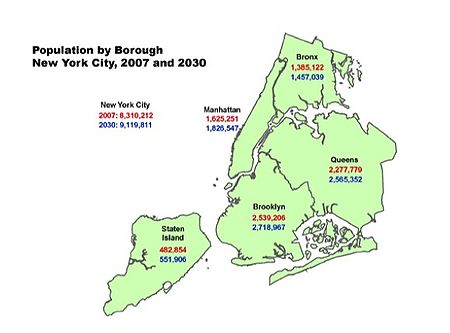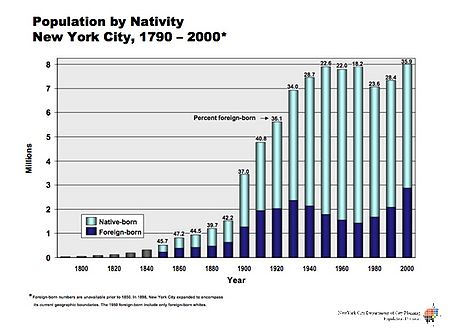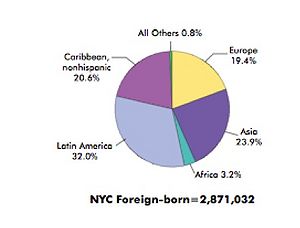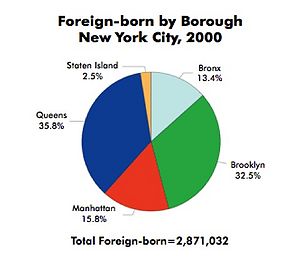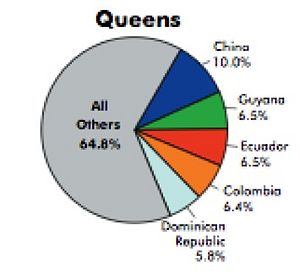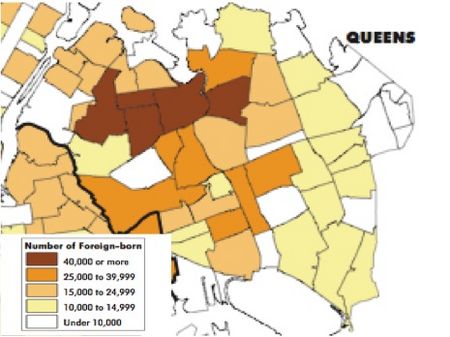From Queens: The Brand Residents Don't Buy
Cities- like people- have personalities since they are made up of more than one ethnic group. One main factor in the cultivation of the New York City personality is immigration. Immigrants themselves have changed in certain ways to adapt to their new environment and they have simultaneously changed the city as well. Without them, the institutions, politics, culture, and very lifestyle of New Yorkers would be greatly different.
To get a better idea of where these immigrants live and are situated, here are some graphs and diagrams that illustrate certain points.
As can be seen from the map, Queens has the second highest population of all the boroughs in the city, not only because it is larger in area than the other boroughs but also because it is conveniently located near three other boroughs as well.
Gradually, through the mid 19th and early 20th century, the rate of foreign-born people has been rising, just as the rate of the native-born has. Although the rate of native-born New Yorkers far out-shadows that of the foreign-born, the percentages show that it is still quite a lot. But where do the foreign-born immigrants come from?
This chart shows the percentage of immigrants that come from each continent, without going into specifics such as certain cities and places. The highest percentage of foreign-born comes from Latin America, followed by Asia, the Caribbean, and Europe, to make up more than 95% of all immigrants in the city. Now, where do all these foreign-born immigrants choose to stay in New York City?
In this chart, Queens and Brooklyn dominate as the two places with the highest percentage of foreign-born residents and where most immigrants are likely to move to upon arriving in New York.
Queens:
Immigration is especially important in the history of Queens, now the most diverse borough of the city. In the beginning around the time of colonial America, Queens started off as an undeveloped, sparsely populated rural area. Now it is a miniature microcosm of the entire world, with immigrants from all countries and cultures flooding in to live here. In fact, if one takes the 7 train on the subway, it passes through the majority of Queens and reveals the different neighborhoods and shops from a bird's eye view- letting the viewer see the different immigrants and cultures that make up the various neighborhoods of Queens. It is no wonder that the 7 train is also called the International Express; Queens is truly a polyethnic area.
And again, here are a few charts that show the diversity within Queens.
From 1990 to 2000, Queens has continuously been receiving immigrants. Now, almost 50% of Queens is foreign-born, an important detail which again reaffirms the fact that Queens is multi-cultural and diverse.
In this chart the details of foreign-born residents in Queens are made clear- approximately 25% of the immigrants are from Latin America and Central America and another 10% are Chinese. The other 65% are a conglomerate of European immigrants, African immigrants, and other immigrants.
Finally, this last chart lays out the population of the immigrants in Queens and where most of these immigrants are situated. Naturally, the number is highest in the northwest corner of Queens, since that part of the borough is closest to the city- undoubtedly where many of these immigrants go to work and make a living. As you go farther east and south, away from Manhattan, Brooklyn, and the Bronx the numbers and shading of the map gets lighter since it is farther away from the other areas and transportation is more difficult and time-consuming.
